Leadership Case Study: Smartphone Use and Road Safety Measures
VerifiedAdded on 2022/11/23
|6
|1492
|299
Case Study
AI Summary
This case study examines the leadership challenges faced by a smartphone manufacturing company concerning the impact of their products on road safety. The scenario presents a leadership retreat where executives discuss the positive and negative societal effects of smartphones. The analysis highlights the differing perspectives of company leaders, including the technology chief, Olivia, and CEO Raphael, who emphasize the benefits, and the marketing manager, Derek, who acknowledges the negative consequences of distracted driving. The case underscores the importance of ethical leadership, corporate social responsibility, and the need for industry leaders to promote safer smartphone use. It emphasizes the need for strategies such as driving modes, awareness campaigns, and a balanced view of product impacts. The included annotated bibliography provides additional research on decision-making models and the effects of technology on driving behavior, offering a comprehensive understanding of the issues. The case study concludes that leaders must consider the ethical and societal implications of their products, not just profit margins, and actively work to mitigate negative impacts.
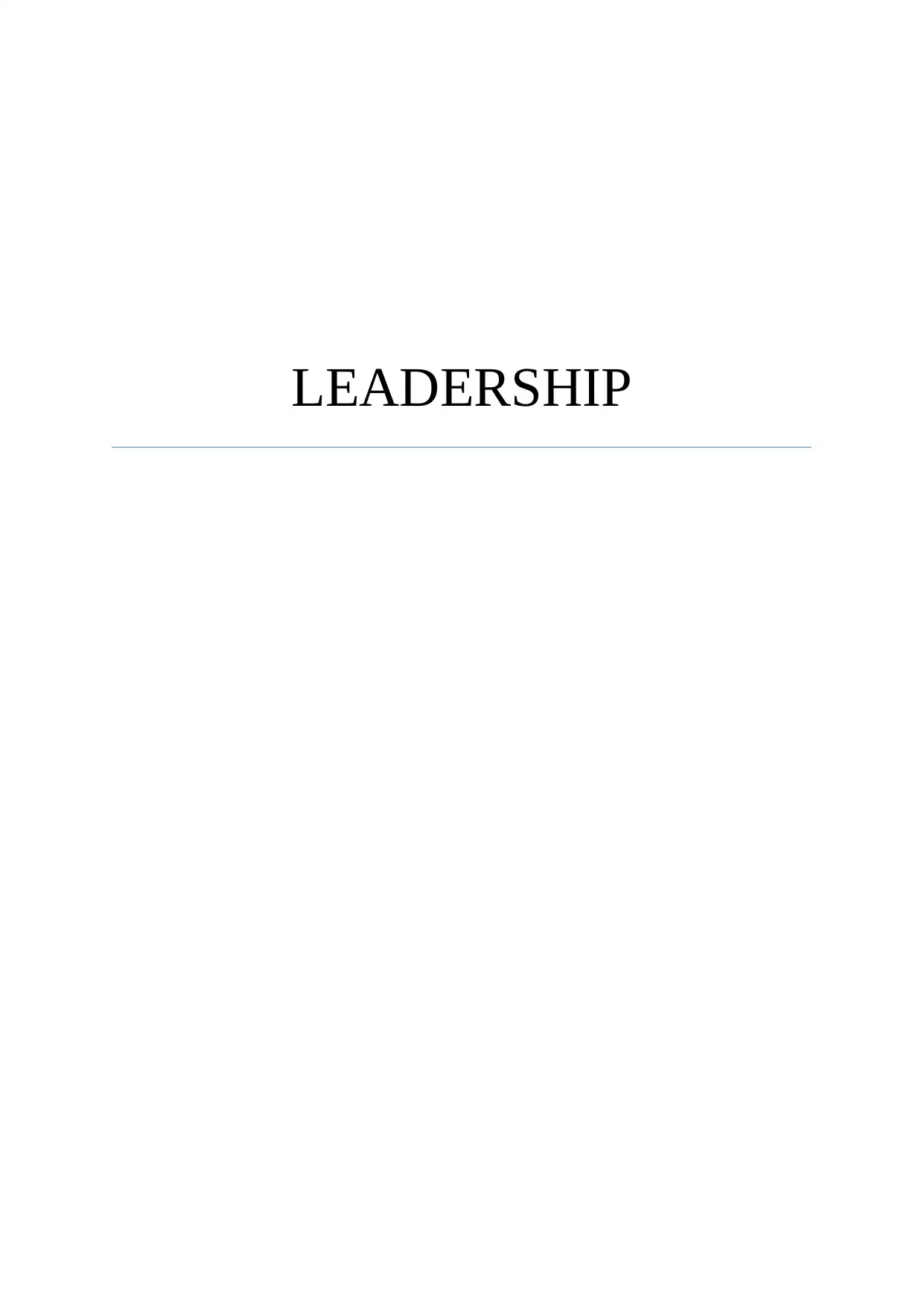
LEADERSHIP
Paraphrase This Document
Need a fresh take? Get an instant paraphrase of this document with our AI Paraphraser
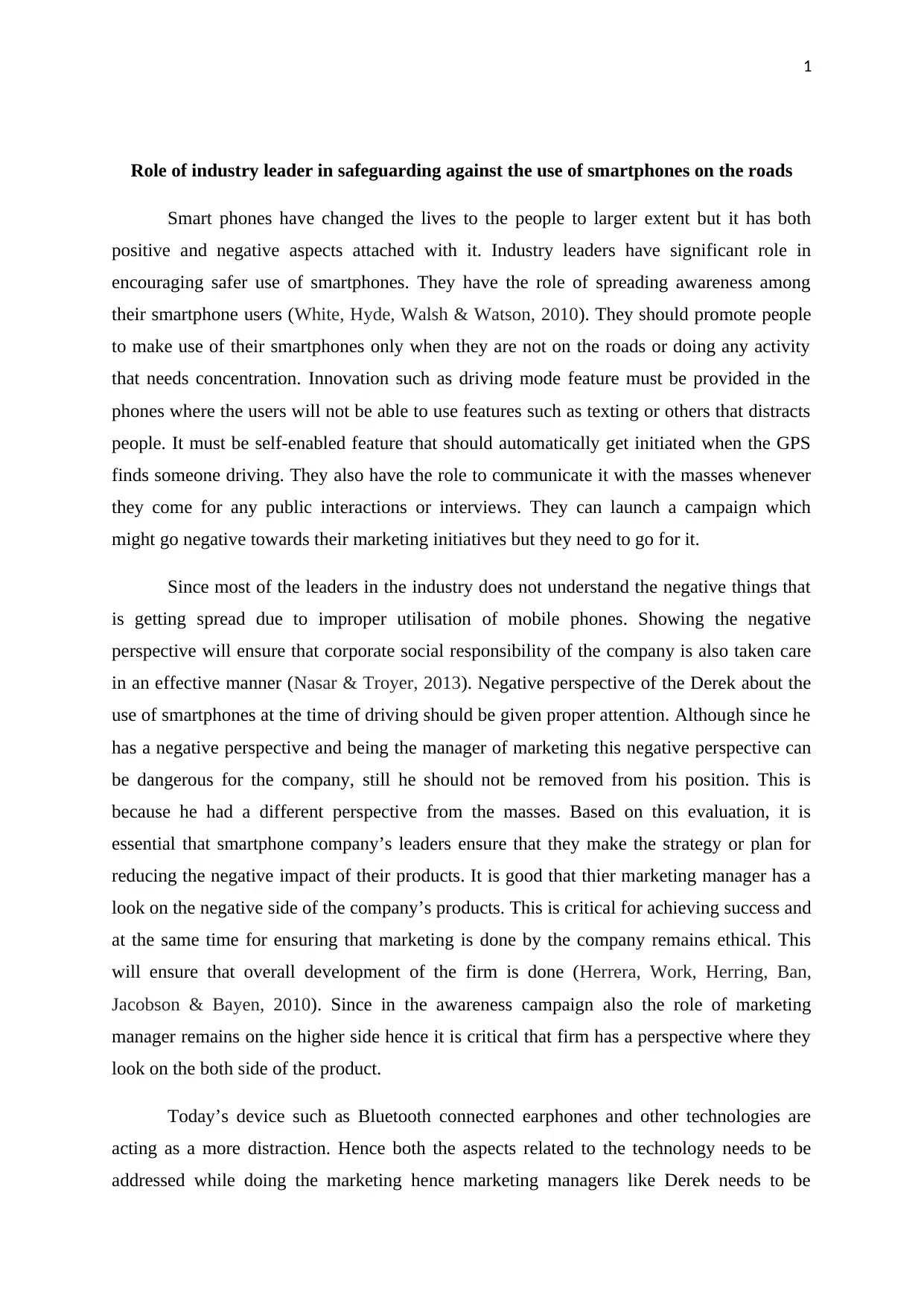
1
Role of industry leader in safeguarding against the use of smartphones on the roads
Smart phones have changed the lives to the people to larger extent but it has both
positive and negative aspects attached with it. Industry leaders have significant role in
encouraging safer use of smartphones. They have the role of spreading awareness among
their smartphone users (White, Hyde, Walsh & Watson, 2010). They should promote people
to make use of their smartphones only when they are not on the roads or doing any activity
that needs concentration. Innovation such as driving mode feature must be provided in the
phones where the users will not be able to use features such as texting or others that distracts
people. It must be self-enabled feature that should automatically get initiated when the GPS
finds someone driving. They also have the role to communicate it with the masses whenever
they come for any public interactions or interviews. They can launch a campaign which
might go negative towards their marketing initiatives but they need to go for it.
Since most of the leaders in the industry does not understand the negative things that
is getting spread due to improper utilisation of mobile phones. Showing the negative
perspective will ensure that corporate social responsibility of the company is also taken care
in an effective manner (Nasar & Troyer, 2013). Negative perspective of the Derek about the
use of smartphones at the time of driving should be given proper attention. Although since he
has a negative perspective and being the manager of marketing this negative perspective can
be dangerous for the company, still he should not be removed from his position. This is
because he had a different perspective from the masses. Based on this evaluation, it is
essential that smartphone company’s leaders ensure that they make the strategy or plan for
reducing the negative impact of their products. It is good that thier marketing manager has a
look on the negative side of the company’s products. This is critical for achieving success and
at the same time for ensuring that marketing is done by the company remains ethical. This
will ensure that overall development of the firm is done (Herrera, Work, Herring, Ban,
Jacobson & Bayen, 2010). Since in the awareness campaign also the role of marketing
manager remains on the higher side hence it is critical that firm has a perspective where they
look on the both side of the product.
Today’s device such as Bluetooth connected earphones and other technologies are
acting as a more distraction. Hence both the aspects related to the technology needs to be
addressed while doing the marketing hence marketing managers like Derek needs to be
Role of industry leader in safeguarding against the use of smartphones on the roads
Smart phones have changed the lives to the people to larger extent but it has both
positive and negative aspects attached with it. Industry leaders have significant role in
encouraging safer use of smartphones. They have the role of spreading awareness among
their smartphone users (White, Hyde, Walsh & Watson, 2010). They should promote people
to make use of their smartphones only when they are not on the roads or doing any activity
that needs concentration. Innovation such as driving mode feature must be provided in the
phones where the users will not be able to use features such as texting or others that distracts
people. It must be self-enabled feature that should automatically get initiated when the GPS
finds someone driving. They also have the role to communicate it with the masses whenever
they come for any public interactions or interviews. They can launch a campaign which
might go negative towards their marketing initiatives but they need to go for it.
Since most of the leaders in the industry does not understand the negative things that
is getting spread due to improper utilisation of mobile phones. Showing the negative
perspective will ensure that corporate social responsibility of the company is also taken care
in an effective manner (Nasar & Troyer, 2013). Negative perspective of the Derek about the
use of smartphones at the time of driving should be given proper attention. Although since he
has a negative perspective and being the manager of marketing this negative perspective can
be dangerous for the company, still he should not be removed from his position. This is
because he had a different perspective from the masses. Based on this evaluation, it is
essential that smartphone company’s leaders ensure that they make the strategy or plan for
reducing the negative impact of their products. It is good that thier marketing manager has a
look on the negative side of the company’s products. This is critical for achieving success and
at the same time for ensuring that marketing is done by the company remains ethical. This
will ensure that overall development of the firm is done (Herrera, Work, Herring, Ban,
Jacobson & Bayen, 2010). Since in the awareness campaign also the role of marketing
manager remains on the higher side hence it is critical that firm has a perspective where they
look on the both side of the product.
Today’s device such as Bluetooth connected earphones and other technologies are
acting as a more distraction. Hence both the aspects related to the technology needs to be
addressed while doing the marketing hence marketing managers like Derek needs to be
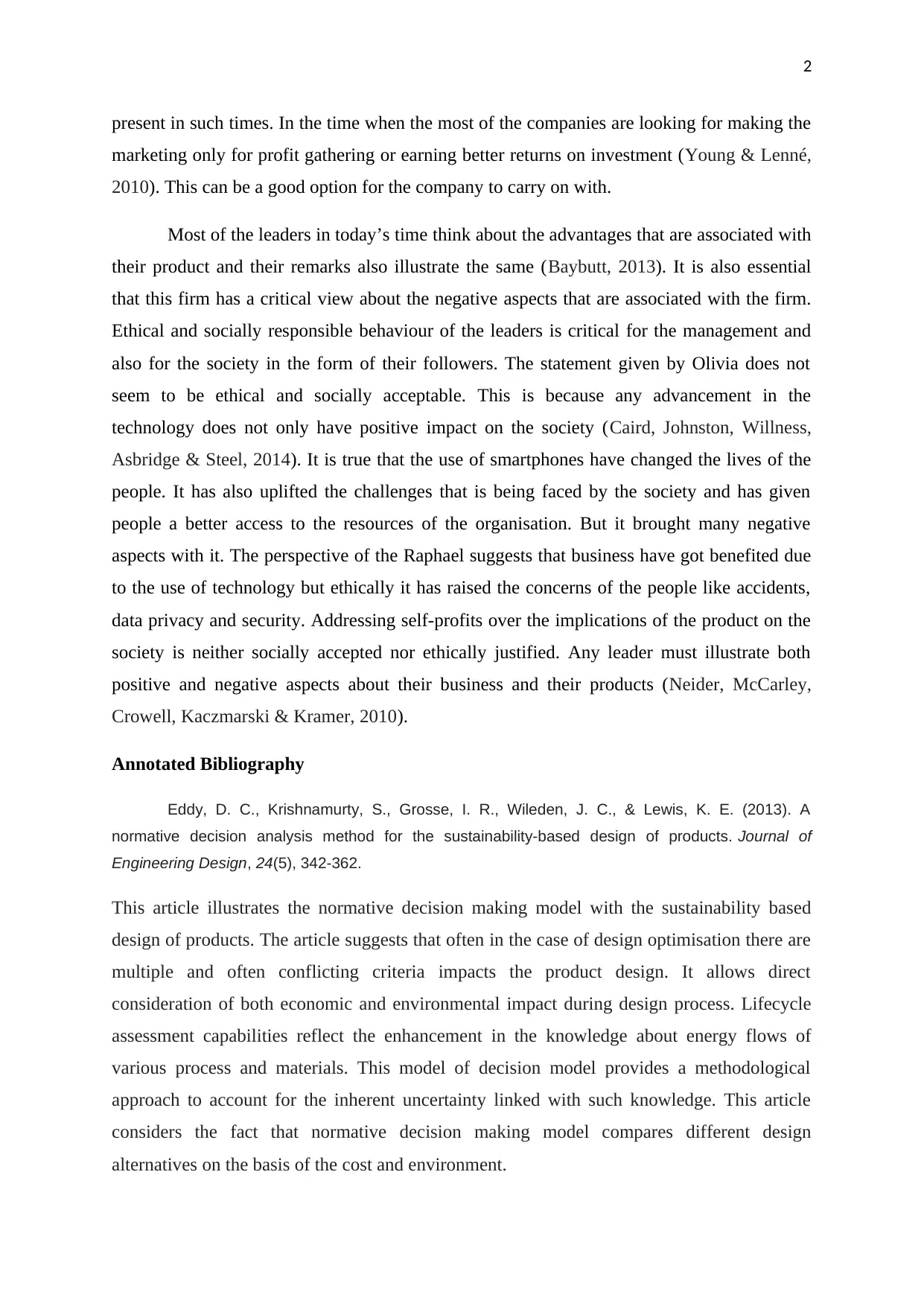
2
present in such times. In the time when the most of the companies are looking for making the
marketing only for profit gathering or earning better returns on investment (Young & Lenné,
2010). This can be a good option for the company to carry on with.
Most of the leaders in today’s time think about the advantages that are associated with
their product and their remarks also illustrate the same (Baybutt, 2013). It is also essential
that this firm has a critical view about the negative aspects that are associated with the firm.
Ethical and socially responsible behaviour of the leaders is critical for the management and
also for the society in the form of their followers. The statement given by Olivia does not
seem to be ethical and socially acceptable. This is because any advancement in the
technology does not only have positive impact on the society (Caird, Johnston, Willness,
Asbridge & Steel, 2014). It is true that the use of smartphones have changed the lives of the
people. It has also uplifted the challenges that is being faced by the society and has given
people a better access to the resources of the organisation. But it brought many negative
aspects with it. The perspective of the Raphael suggests that business have got benefited due
to the use of technology but ethically it has raised the concerns of the people like accidents,
data privacy and security. Addressing self-profits over the implications of the product on the
society is neither socially accepted nor ethically justified. Any leader must illustrate both
positive and negative aspects about their business and their products (Neider, McCarley,
Crowell, Kaczmarski & Kramer, 2010).
Annotated Bibliography
Eddy, D. C., Krishnamurty, S., Grosse, I. R., Wileden, J. C., & Lewis, K. E. (2013). A
normative decision analysis method for the sustainability-based design of products. Journal of
Engineering Design, 24(5), 342-362.
This article illustrates the normative decision making model with the sustainability based
design of products. The article suggests that often in the case of design optimisation there are
multiple and often conflicting criteria impacts the product design. It allows direct
consideration of both economic and environmental impact during design process. Lifecycle
assessment capabilities reflect the enhancement in the knowledge about energy flows of
various process and materials. This model of decision model provides a methodological
approach to account for the inherent uncertainty linked with such knowledge. This article
considers the fact that normative decision making model compares different design
alternatives on the basis of the cost and environment.
present in such times. In the time when the most of the companies are looking for making the
marketing only for profit gathering or earning better returns on investment (Young & Lenné,
2010). This can be a good option for the company to carry on with.
Most of the leaders in today’s time think about the advantages that are associated with
their product and their remarks also illustrate the same (Baybutt, 2013). It is also essential
that this firm has a critical view about the negative aspects that are associated with the firm.
Ethical and socially responsible behaviour of the leaders is critical for the management and
also for the society in the form of their followers. The statement given by Olivia does not
seem to be ethical and socially acceptable. This is because any advancement in the
technology does not only have positive impact on the society (Caird, Johnston, Willness,
Asbridge & Steel, 2014). It is true that the use of smartphones have changed the lives of the
people. It has also uplifted the challenges that is being faced by the society and has given
people a better access to the resources of the organisation. But it brought many negative
aspects with it. The perspective of the Raphael suggests that business have got benefited due
to the use of technology but ethically it has raised the concerns of the people like accidents,
data privacy and security. Addressing self-profits over the implications of the product on the
society is neither socially accepted nor ethically justified. Any leader must illustrate both
positive and negative aspects about their business and their products (Neider, McCarley,
Crowell, Kaczmarski & Kramer, 2010).
Annotated Bibliography
Eddy, D. C., Krishnamurty, S., Grosse, I. R., Wileden, J. C., & Lewis, K. E. (2013). A
normative decision analysis method for the sustainability-based design of products. Journal of
Engineering Design, 24(5), 342-362.
This article illustrates the normative decision making model with the sustainability based
design of products. The article suggests that often in the case of design optimisation there are
multiple and often conflicting criteria impacts the product design. It allows direct
consideration of both economic and environmental impact during design process. Lifecycle
assessment capabilities reflect the enhancement in the knowledge about energy flows of
various process and materials. This model of decision model provides a methodological
approach to account for the inherent uncertainty linked with such knowledge. This article
considers the fact that normative decision making model compares different design
alternatives on the basis of the cost and environment.
⊘ This is a preview!⊘
Do you want full access?
Subscribe today to unlock all pages.

Trusted by 1+ million students worldwide
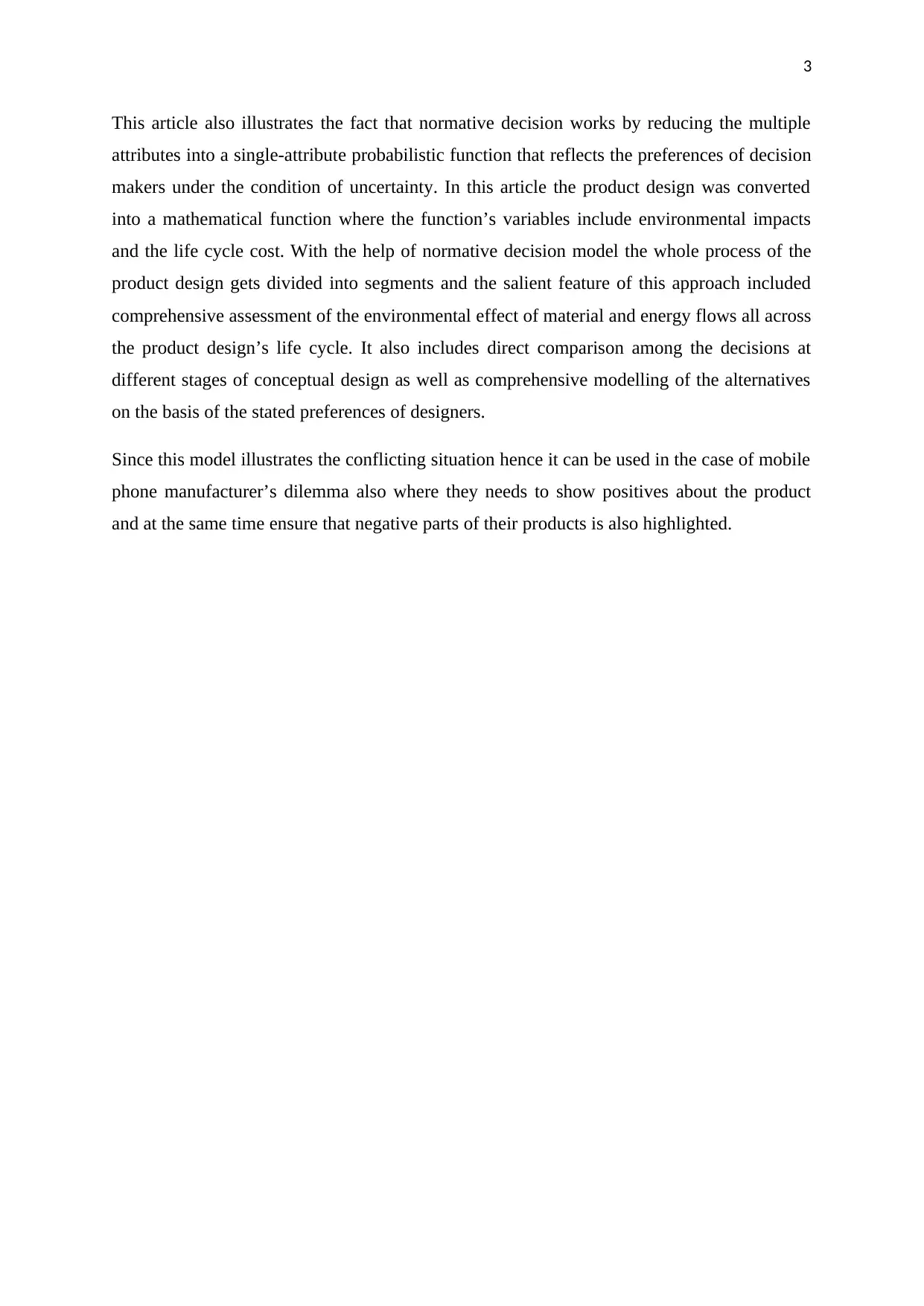
3
This article also illustrates the fact that normative decision works by reducing the multiple
attributes into a single-attribute probabilistic function that reflects the preferences of decision
makers under the condition of uncertainty. In this article the product design was converted
into a mathematical function where the function’s variables include environmental impacts
and the life cycle cost. With the help of normative decision model the whole process of the
product design gets divided into segments and the salient feature of this approach included
comprehensive assessment of the environmental effect of material and energy flows all across
the product design’s life cycle. It also includes direct comparison among the decisions at
different stages of conceptual design as well as comprehensive modelling of the alternatives
on the basis of the stated preferences of designers.
Since this model illustrates the conflicting situation hence it can be used in the case of mobile
phone manufacturer’s dilemma also where they needs to show positives about the product
and at the same time ensure that negative parts of their products is also highlighted.
This article also illustrates the fact that normative decision works by reducing the multiple
attributes into a single-attribute probabilistic function that reflects the preferences of decision
makers under the condition of uncertainty. In this article the product design was converted
into a mathematical function where the function’s variables include environmental impacts
and the life cycle cost. With the help of normative decision model the whole process of the
product design gets divided into segments and the salient feature of this approach included
comprehensive assessment of the environmental effect of material and energy flows all across
the product design’s life cycle. It also includes direct comparison among the decisions at
different stages of conceptual design as well as comprehensive modelling of the alternatives
on the basis of the stated preferences of designers.
Since this model illustrates the conflicting situation hence it can be used in the case of mobile
phone manufacturer’s dilemma also where they needs to show positives about the product
and at the same time ensure that negative parts of their products is also highlighted.
Paraphrase This Document
Need a fresh take? Get an instant paraphrase of this document with our AI Paraphraser
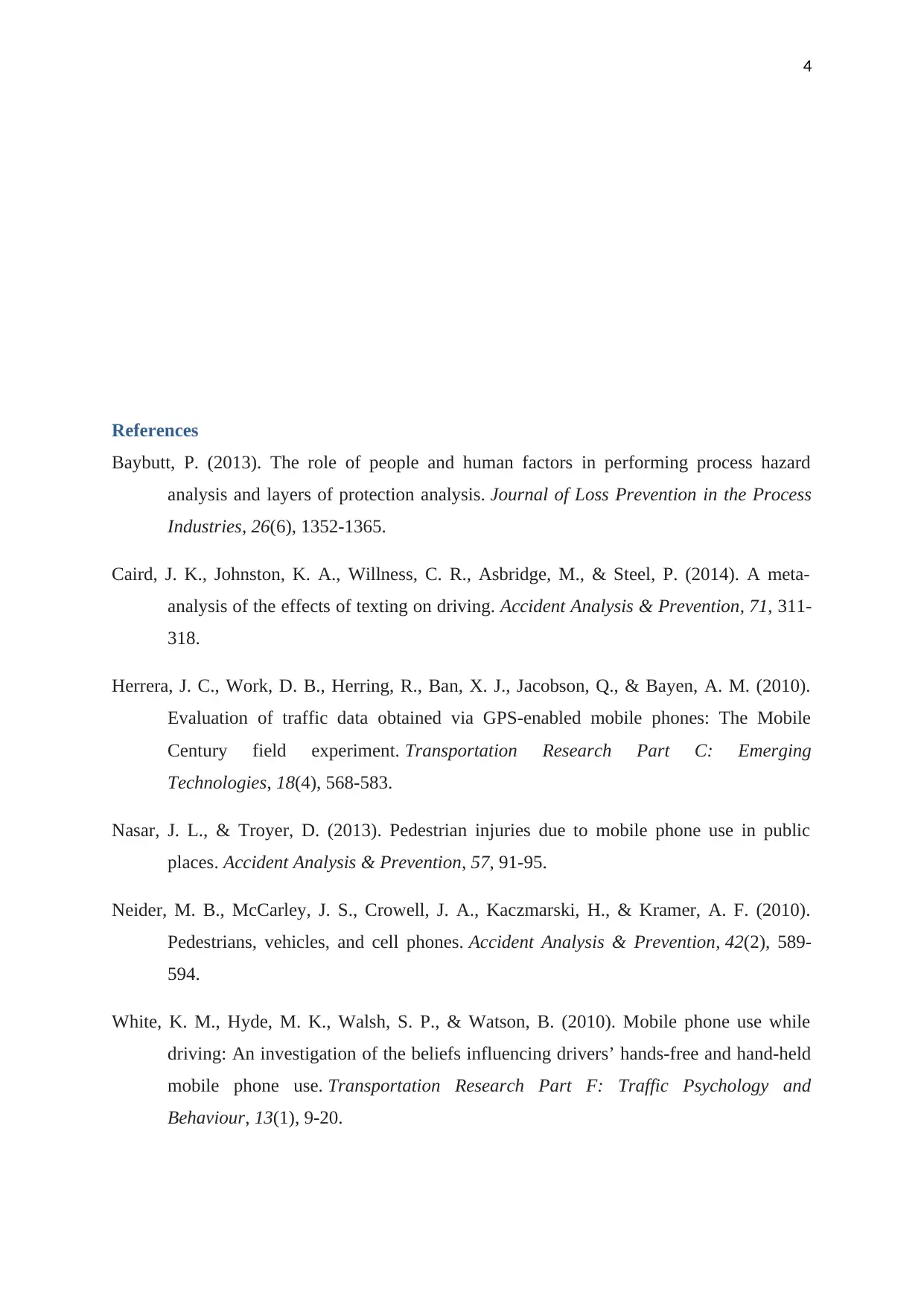
4
References
Baybutt, P. (2013). The role of people and human factors in performing process hazard
analysis and layers of protection analysis. Journal of Loss Prevention in the Process
Industries, 26(6), 1352-1365.
Caird, J. K., Johnston, K. A., Willness, C. R., Asbridge, M., & Steel, P. (2014). A meta-
analysis of the effects of texting on driving. Accident Analysis & Prevention, 71, 311-
318.
Herrera, J. C., Work, D. B., Herring, R., Ban, X. J., Jacobson, Q., & Bayen, A. M. (2010).
Evaluation of traffic data obtained via GPS-enabled mobile phones: The Mobile
Century field experiment. Transportation Research Part C: Emerging
Technologies, 18(4), 568-583.
Nasar, J. L., & Troyer, D. (2013). Pedestrian injuries due to mobile phone use in public
places. Accident Analysis & Prevention, 57, 91-95.
Neider, M. B., McCarley, J. S., Crowell, J. A., Kaczmarski, H., & Kramer, A. F. (2010).
Pedestrians, vehicles, and cell phones. Accident Analysis & Prevention, 42(2), 589-
594.
White, K. M., Hyde, M. K., Walsh, S. P., & Watson, B. (2010). Mobile phone use while
driving: An investigation of the beliefs influencing drivers’ hands-free and hand-held
mobile phone use. Transportation Research Part F: Traffic Psychology and
Behaviour, 13(1), 9-20.
References
Baybutt, P. (2013). The role of people and human factors in performing process hazard
analysis and layers of protection analysis. Journal of Loss Prevention in the Process
Industries, 26(6), 1352-1365.
Caird, J. K., Johnston, K. A., Willness, C. R., Asbridge, M., & Steel, P. (2014). A meta-
analysis of the effects of texting on driving. Accident Analysis & Prevention, 71, 311-
318.
Herrera, J. C., Work, D. B., Herring, R., Ban, X. J., Jacobson, Q., & Bayen, A. M. (2010).
Evaluation of traffic data obtained via GPS-enabled mobile phones: The Mobile
Century field experiment. Transportation Research Part C: Emerging
Technologies, 18(4), 568-583.
Nasar, J. L., & Troyer, D. (2013). Pedestrian injuries due to mobile phone use in public
places. Accident Analysis & Prevention, 57, 91-95.
Neider, M. B., McCarley, J. S., Crowell, J. A., Kaczmarski, H., & Kramer, A. F. (2010).
Pedestrians, vehicles, and cell phones. Accident Analysis & Prevention, 42(2), 589-
594.
White, K. M., Hyde, M. K., Walsh, S. P., & Watson, B. (2010). Mobile phone use while
driving: An investigation of the beliefs influencing drivers’ hands-free and hand-held
mobile phone use. Transportation Research Part F: Traffic Psychology and
Behaviour, 13(1), 9-20.

5
Young, K. L., & Lenné, M. G. (2010). Driver engagement in distracting activities and the
strategies used to minimise risk. Safety Science, 48(3), 326-332.
Young, K. L., & Lenné, M. G. (2010). Driver engagement in distracting activities and the
strategies used to minimise risk. Safety Science, 48(3), 326-332.
⊘ This is a preview!⊘
Do you want full access?
Subscribe today to unlock all pages.

Trusted by 1+ million students worldwide
1 out of 6
Your All-in-One AI-Powered Toolkit for Academic Success.
+13062052269
info@desklib.com
Available 24*7 on WhatsApp / Email
![[object Object]](/_next/static/media/star-bottom.7253800d.svg)
Unlock your academic potential
Copyright © 2020–2025 A2Z Services. All Rights Reserved. Developed and managed by ZUCOL.

